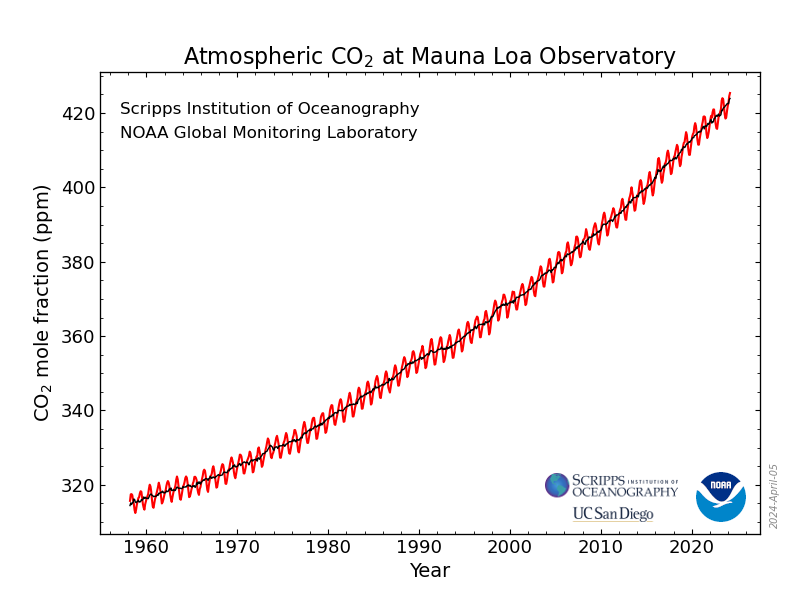Overview of 2023's CO2 Weekly and Monthly Concentration Data at the Mauna Loa Observatory. [View all]
Last edited Sun Jan 14, 2024, 10:44 AM - Edit history (1)
As I've indicated repeatedly in my DU writings, somewhat obsessively I keep a spreadsheet of the weekly data at the Mauna Loa Carbon Dioxide Observatory, which I use to do calculations to record the dying of our atmosphere, a triumph of fear, dogma and ignorance that did not have to be, but nonetheless is, a fact.
Facts matter.
When writing these depressing repeating posts about new records being set, reminiscent, over the years, to the ticking of a clock at a deathwatch, I often repeat some of the language from a previous post on this awful series, as I have been doing here with some modifications. It saves time.
As I note in this series of posts, the concentrations of the dangerous fossil fuel waste carbon dioxide which are killing the planet fluctuate sinusoidally over the year, with the rough sine wave superimposed on a quadratic axis:

Monthly Average Mauna Loa CO2
In this particular post, I will look over the weekly and monthly data reported at the Observatory, which like every year of the 21st century has set new records for the highest concentration of the dangerous fossil fuel waste carbon dioxide.
Here is the data for week 52, which includes the first days of 2024:
Week beginning on December 31, 2023: 422.40 ppm
Weekly value from 1 year ago: 419.34 ppm
Weekly value from 10 years ago: 397.73 ppm
Last updated: January 06, 2024
Weekly average CO2 at Mauna Loa
This is, if one hasn't joined Greenpeace and can thus add and subtract, 3.06 ppm higher than week 52 of 2022.
Overall the average increase week to week comparators among the 52 weeks of 2023 with those of 2022 was 2.56 ppm.
The average weekly concentration of the dangerous fossil fuel waste carbon dioxide in the planetary atmosphere was, in 2023, 421.13 ppm, compared to 418.27 ppm in 2022, 416.42 ppm in 2021, and 414.03 ppm in 2000.
The highest concentration, an all time record, was set in the week beginning May 28, 2023, 424.64 ppm.
Four of the 50 highest weekly values out of 2501 weekly data reported at Mauna Loa going back to 1975 occurred in 2023. Of these 50 top highest, 12 have occurred in the last 5 years; 33 occurred in the last 10 years, and 40 in the 21st century. Of the 10 that occurred in the 20th century, six occurred in 1998 when the rain forests in S.E. Asia caught fire after slash and burn fires set to make palm oil plantations for "renewable biodiesel" for Germany went out of control.
There have been 65 years of monthly data recorded at Mauna Loa. January 2023 through March 2023 were relatively mild, with average concentrations were "only" 1.53 ppm higher than the same months of 2022. April 2023's increase over April 2022 was 3.05 ppm, the third highest April increase reported, as was May 2023's increase of 3.01 ppm over May 2022, June (2.69 ppm), the 6th highest ever, July 2023, (3.24 ppm) the second highest ever recorded, October (3.04 ppm) the 3rd highest ever recorded, November (2.95 ppm) the 4th highest ever recorded, and December (2.91 ppm) the 2nd highest ever recorded at Mauna Loa.
Maybe someone here thinks we're doing something about climate change.
We aren't.
Enjoy the rest of the weekend and, oh yeah, happy New Year.
